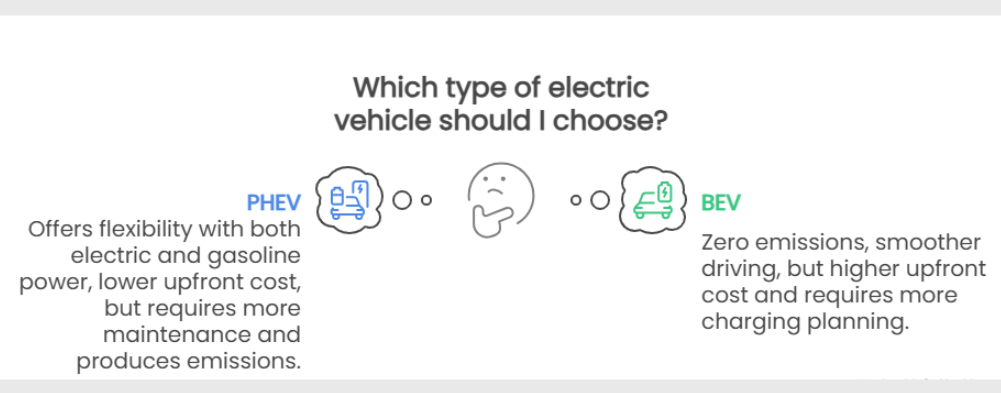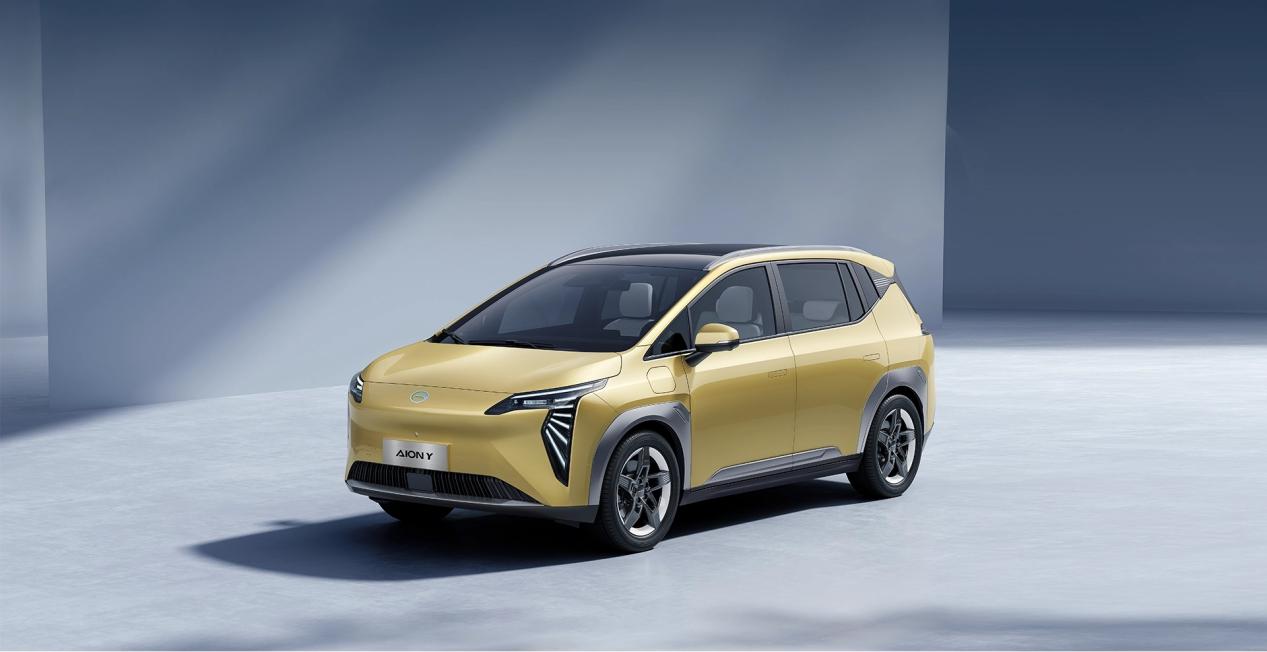The pressing demand for sustainability, lower emissions, and enhanced energy efficiency is driving a significant shift in the global automotive sector towards electrification. We at GAC have witnessed this revolution firsthand, especially in the dynamic European market. Electrified vehicles are no longer a niche. They are a significant and growing force. According to the ACEA, in April 2025, battery-electric vehicles (BEV) accounted for 15.3% of the total EU market share, while plug-in hybrid electric vehicles (PHEV) accounted for 7.9% of total car registrations.[1] This highlights their rising significance and leads us to a crucial question for many drivers: what is a plug-in hybrid and battery-electric vehicle? What are the key differences between PHEV vs BEV, and which one would be the most suitable for my individual needs?

Demystifying PHEV and BEV: A Closer Look
To make an informed decision, it's essential to understand the core characteristics of each.
1. Basic Working Principle
PHEV combines a smaller battery with a fuel-based internal combustion engine (ICE). It can run with electricity in a limited range, usually 25-60 miles. Then, switch to a gasoline engine for extended travel. Examples include GAC E9, EMKOO, and GS4.
BEV is powered solely by electricity. That means it has no ICE, no fuel tank and no exhaust pipe. Instead, it is equipped with one or more electric motors powered by a larger onboard battery. Examples include AION Y, AION V, and Hyptec HT.
2. Charging Option
For PHEVs, charging is flexible. You can charge the battery by plugging it into a standard wall outlet (Level 1), a faster home charger (Level 2), or even through regenerative braking while driving.
BEV requires charging through an external outlet. There are three main levels. Level 1 charging(standard 120V outlet) is the slowest, suitable for overnight home charging. Level 2 chargers(240V AC outlet) are faster and commonly found in homes, workplaces, and public stations. In contrast, level 3 (DC Fast Charging) powers your EV in under an hour.
3. Electric-only Range
The typical electric-only range for a PHEV varies but can often cover daily commutes, usually between 25 to 60 miles. For example, when you head out of your house for work in the morning and travel at a slow pace on city streets, the PHEV will entirely rely on the electric motor, keeping the engine from starting.
In contrast, the range of a BEV is generally much greater than a PHEV, with many models offering several hundred kilometres on a single charge. Therefore, when you drive a BEV, you’re embracing a fully electric future.
4. Maintenance
PHEV maintenance is a hybrid of traditional and electric vehicle upkeep. They need to repair ICE components, such as oil changes and exhaust systems. Therefore, it will increase complexity and expenses over time.
While BEVs are simpler and more cost-effective. There's no oil to change, no spark plugs to replace, and the regenerative braking system reduces wear on traditional brake pads. However, tyre wear can be higher due to instant torque and vehicle weight.
5. Others
PHEVs offer the advantage of “range anxiety” elimination, as the gasoline engine provides a backup for longer trips or when charging isn't readily available. They also often have a lower upfront cost than BEVs. However, they still produce emissions when running on gasoline and require two fuel sources.
BEVs produce zero emissions during operation, aligning perfectly with the EU's environmental goals. In addition, it often provides a smoother, quieter driving experience with instant torque. The primary disadvantages may include a greater upfront cost and the requirement for more deliberate planning for extended trips, although the charging network is growing quickly in the EU.

Factors Influencing Your Choice
Deciding between PHEV vs BEV in the EU market depends on several factors:
1. Environmental Goal
If your objective is to reduce carbon emissions and advocate for zero-emission transport, BEVs are the only options since they produce no tailpipe emissions and help meet strict EU climate targets. But if you are looking for a transitional option that provides a certain level of electric driving while maintaining some level of fuel flexibility, PHEVs may help you reduce your emissions in comparison to conventional vehicles.
2. Application Scenario
Consider your daily driving habits. If your commute is short and you have consistent access to charging, a BEV could be ideal, allowing you to maximize electric-only driving. If your driving involves frequent long-distance trips or rural areas with limited charging infrastructure, a PHEV might offer more flexibility.
3. Charging Accessibility
Europe surpassed the milestone of one million public charging points by the end of the first quarter of 2025.[2] However, its accessibility still varies by region and specific location. In Europe, access to home chargers is far higher. If you live in an apartment or don’t have a dedicated parking spot, public charging infrastructure becomes crucial. A BEV user will be more reliant on this network than a PHEV user.
GAC's Vision for BEV in the EU
At GAC, we acknowledge the increasing demand for BEVs within the EU. As a result, we produce innovative, high-quality BEVs that cater to the many needs of consumers. Our AION Y showcases this commitment.
The AION Y is a new trend pure electric SUV built on GAC’s GEP 2.0 platform, providing generous interior spaciousness with a 2750mm wheelbase. It features a 63.2 kWh LFP battery, which ensures safety and durability even at temperatures exceeding 1400°C. This battery enables a WLTP driving range of up to 430 km and supports DC fast charging, allowing for a 30% to 80% charge in just 34 minutes.
In addition, the AION Y is equipped with advanced safety features and intelligent systems, such as Automatic Emergency Braking, Adaptive Cruise Control, and Lane Departure Warning. It enhances the driving experience for European consumers seeking practicality and modern technology.

Conclusion
The ultimate decision between PHEV vs BEV is contingent upon personal preference, application scenario and accessibility to charging. BEVs are ideal for those who are committed to zero emissions driving and lower maintenance, whereas PHEVs offer flexibility and longer range for diverse driving needs.
As the EU market moves quickly towards electric cars, GAC Motor is prepared with our knowledge and new BEVs like the AION Y to meet the changing needs of European drivers. With many years in the electric vehicle industry, GAC is happy to help create a cleaner and more sustainable future with advanced electric mobility options. With GAC, you can be assured of a driving experience that combines cutting-edge technology, reliability, and a commitment to a greener future.
References
1. New car registrations: -1.2% in April 2025 year-to-date; battery-electric 15.3% marketshare. Available at: https://www.acea.auto/pc-registrations/new-car-registrations-1-2-in-april-2025-year-to-date-battery-electric-15-3-market-share/ (Accessed: June 6, 2025)
2. Electric vehicle charging – Global EV Outlook 2025. Available at: https://www.iea.org/reports/global-ev-outlook-2025/electric-vehicle-charging(Accessed: June 6, 2025)


